Black currant variety An ordinary miracle: features, rules for planting, care and reproduction
Despite the fact that black currant is considered an unpretentious plant, problems sometimes arise with its cultivation in some regions of our country. For example, relatively recently, it did not take root well in the northern regions due to severe winters with severe frosts. However, Russian breeders have developed varieties that are characterized by increased frost resistance.
Many of them grow in Siberia, but at the same time they give small berries and a small harvest. The recently bred Blackcurrant Ordinary Miracle is devoid of this drawback - it has large and tasty berries. Read about the features of planting and caring for it below.
The content of the article
Description of black currant variety Ordinary miracle
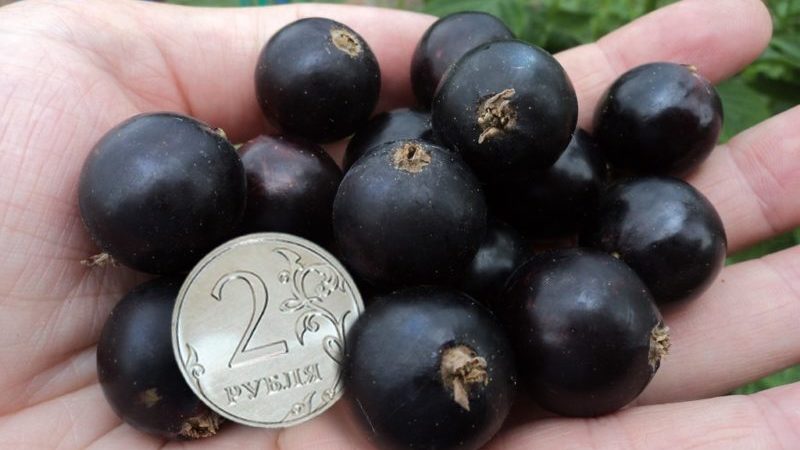
A frost-resistant variety of black currant. An ordinary miracle was bred by Siberian breeders in 1963. In 2004, the culture was entered into the State Register of Russia.
The shrub can withstand frosts down to -40 ° C, which is especially important when grown in Siberia and other northern regions.
Berries are formed in the second year after planting plants... They have a sweet-sour taste and rich aroma. They are characterized by a high content of vitamin C and K, iodine and iron.
The Ordinary Miracle variety is unpretentious in care, drought-resistant and does not require frequent watering.
Note! Of all the varieties of currants, it is black that is considered the most useful and fragrant.
The berries of the Common Miracle have a dense skin. They are suitable for fresh consumption, making desserts and sauces. Does not crack or soften when frozen.
Plant characteristics
Description of currants An ordinary miracle will delight even experienced gardeners.
It is interesting! Currant taste rating An ordinary miracle reaches 4.6 points out of 5.
Bush
The bush is not spreading, with straight branches. The maximum plant height is 2 m. The powerful root system grows in depth and in breadth. Shoots are yellow and gray, eventually becoming bright green on the outside and white on the inside. Bright green leaves have a smooth, shiny surface on one side and rough with pubescence and veins on the other. Sheet plate with 3-5 divisions. Buds are oval, brown. Pale yellow flowers are collected in clusters of 13 pcs. The brushes reach 11 cm in length. Each of them produces 12 berries.
Berries
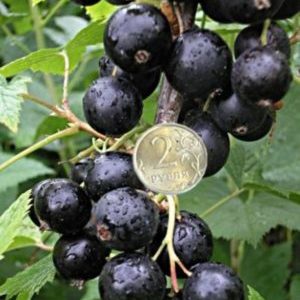
The berries are large. The weight of each varies from 1.5 to 2 g, and the diameter reaches 2 cm. The shell is black with a glossy sheen and a waxy coating. Inside there is amber, dense and juicy pulp. The taste is sweet, sugar. The aroma is pronounced.
Immunity
Tall. The variety is resistant to powdery mildew, septoria, anthracnose, spherotek, leaf spot. An ordinary miracle rarely affects aphids and kidney mites.
Productivity and ripening time
The yield is high. From 1 bush, from 9 to 12 kg are harvested, depending on the region. Medium late variety - berries ripen in the second half of July.
Growing conditions
Suitable for growing in all regions. The highest yields in areas with a temperate climate.
It is interesting:
The best ways to dry black currants at home.
A step-by-step guide to fermenting currant leaves for tea at home.
How and when to collect currant and raspberry leaves for drying for the winter.
Advantages and disadvantages of the variety
Blackcurrant variety An ordinary miracle is popular with gardeners. It has many advantages:
- no need for support;
- high immunity;
- sweet taste and rich aroma;
- large, dense berries;
- frost resistance;
- drought resistance;
- decorativeness of bushes;
- resistance to aphids and kidney mites;
- high productivity;
- good transportability.
The disadvantage of the variety is that when overripe and prolonged exposure to high temperatures, the berries crack.
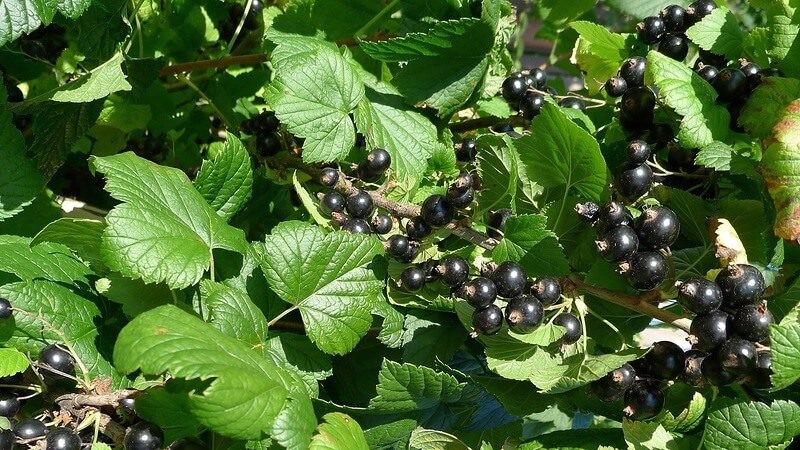
Landing
Saplings of the Ordinary Miracle are recommended to be planted in September. In this case, the plants will have time to take root before the onset of frost, but the buds will not wake up ahead of time.
Spring planting is sometimes practiced. In this case, the work is carried out before the buds of the plants wake up.
Sapling selection
In order for the plant to take root and give a bountiful harvest in the future, it is important to choose high-quality planting material:
- Rhizome. Color - light brown. The main root and a large number of threads must be present. The minimum length of the main root is 15 cm.
- Lack of defects: dried buds, spots, formations and damage on the shoots.
- Bush height - from 40 to 100 cm.
It is recommended to buy currant seedlings from professional nurseries. This will increase the likelihood of obtaining quality planting material of the desired variety.
Note! Postage does not affect the quality of the planting material.
Site selection and seedling preparation
To make the plant feel comfortable and give a bountiful harvest, choose a suitable site for it:
- Groundwater should not run too close to the surface. If there is no such place in the garden, you will have to make an embankment 35-40 cm high.
- Wind protection. Currants are planted near fences, houses and other structures.
- Sunny area. Currant is a light-loving plant. The highest yields are achieved in good lighting conditions.
Currants develop poorly in heavy clay and acidic soils. In the first case, sand will have to be added to the hole, and in the second - dry lime.
The seedling must be prepared in order to stimulate its growth and reduce the likelihood of infection with various diseases:
- Disinfection. Prepare a solution of 5 liters of water and 1 tbsp. l. potassium permanganate and immerse the currant root system in it for 4 hours.
- Growth stimulation. 200 g of "Kornevin" is diluted in 5 liters of water and the seedling is soaked for a day.
- Cutting the roots. If the roots of the plant are too long, they are cut by a third.
Planting process
Instructions for planting currant seedlings:
- Dig a hole 55 cm wide and 40 cm deep. The soil around the hole is weeded.
- The soil removed from the hole is cleaned of weeds and mixed with 0.5 buckets of humus and 1 tbsp. ash. A bucket of the resulting mixture is poured back into the hole and a mound is formed in the center of the depression.
- The seedling is placed in the center of the hole directly on the mound, carefully spreading the roots around the mound.
- Sprinkle with soil so that the root collar of the seedling is covered by 3 cm.
- The soil around the plant is compacted and watered with 3 liters of water. The exposed roots are covered with earth.
- The soil is mulched with straw, sawdust or peat.
Self-pollination of the Ordinary Miracle reaches 40%. It is recommended to plant a few more currant bushes on the site. Otherwise, the yield will be low.
Currant care
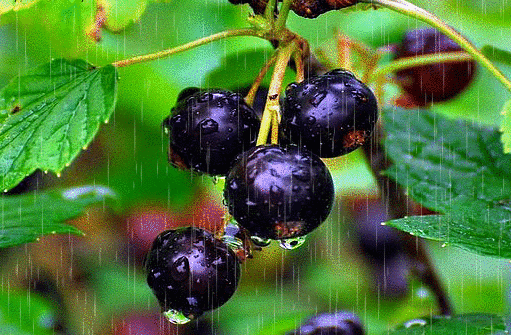
Despite the fact that black currant is an unpretentious crop, it still needs care. The basic rules are presented in the list:
- Inspection. The currants are examined during flowering. In healthy plants, the flowering is bell-shaped, and in sick plants, it is separate-petalled. All terry inflorescences on the plant are removed. If all flowers suffer from such a problem, the currants are completely dug out.
- Watering. In dry summers, currants are watered once every 14 days. In a wet cool period, the soil is moistened once every 4 weeks.3 buckets of warm, settled water are poured under each plant. Watering is especially important during the period of fruit ripening and formation, otherwise they will crack. It is not necessary to water the currants in the spring. It is worth limiting watering during flowering.
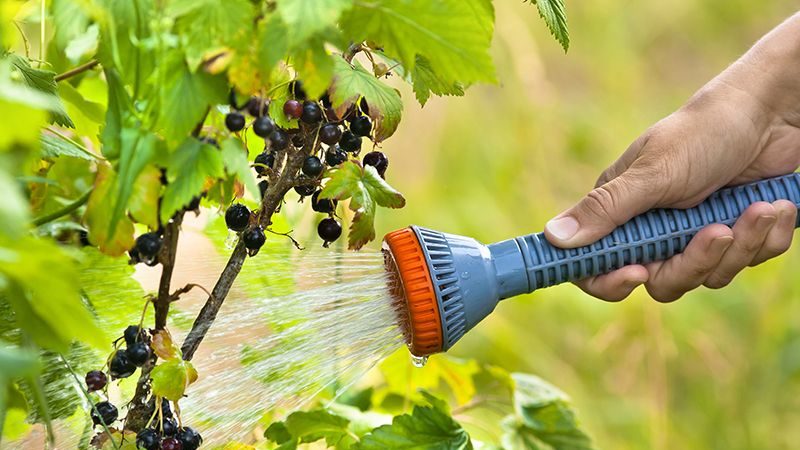
- Loosening. The soil around the currants is loosened to a depth of 10 cm every two weeks. In the process of loosening, weeds are removed.
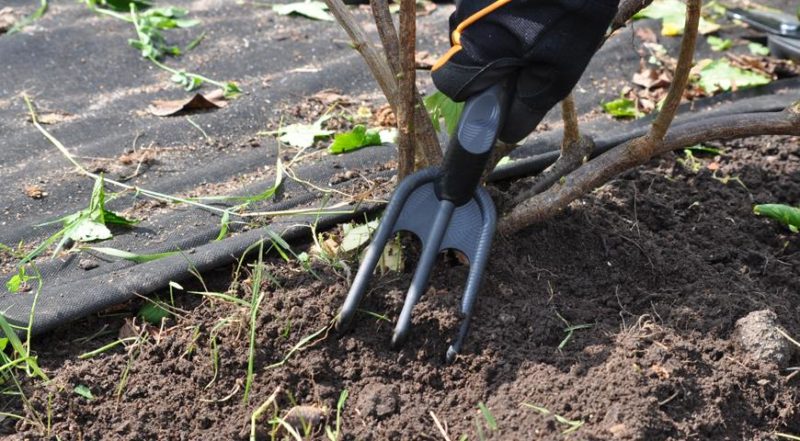
- Mulching protects the plant from cold snaps, moisture stagnation, pests and diseases... In summer, the layer of hay, sawdust, straw or peat should reach 10 cm.In preparation for winter - 30 cm.
- Top dressing. Held 3 times per season: after the snow melts, in June and September.
- Preparing for the winter. It consists in cleaning fallen leaves and plant debris, as well as mulching the bush to a height of 20-30 cm.
Top dressing should be given special attention. For currants, use the following scheme:
- In the spring, the plant is fed with ammonium nitrate. To prepare the fertilizer, 400 g of ammonium nitrate is diluted in 10 liters of water. 3-4 liters of funds are poured under each bush. Fertilizer accelerates the formation of ovaries.
- In June, compost is used as a top dressing. 600 g of compost is diluted in 10 liters of warm water and 5 liters of solution are poured under each bush. The product improves the taste of berries.
- In September, a superphosphate solution is used: 0.5 kg per 10 liters of water. 5 liters of fertilizer are poured under one bush. This will help the currants survive the winter.
The day before fertilization, the bushes must be watered. This reduces the risk of root burns with nutrient formulations.
Important! Water and fertilize early in the morning or at sunset when the sun is inactive. This helps to avoid burns on the leaves.
Pruning
We should also talk about pruning. This nursing phase prevents disease and helps maximize yields. There are 3 types of trimming:
- Sanitary. Remove dry, disease-damaged and old branches.
- Anti-aging. Branches older than 5 years are removed. This is necessary for the formation of young fruiting branches.
- Formative. Small shoots are removed annually, leaving only strong shoots. On a properly formed currant, 15 fruiting branches should form over time. The shoots are shortened so that up to 5 buds remain on each of them.

Pruning is done in spring or fall. It is important that by this time the plant has fallen into a calm state.
Reproduction

Having bought one sapling of the Ordinary Miracle, over time it will be possible to acquire a whole plantation. For this, it is important to know how the plant reproduces:
- Cuttings. Young branches are shortened by 15 cm. The cut-off part is placed in Kornevin's solution for a month. Cuttings that have taken root are planted in large flower pots and left there until spring. Then the finished seedlings are transplanted into open ground.
- Layers. At some distance from the bush, near strong, developed shoots, depressions are dug up to 10 cm. Shoots are placed in them and sprinkled with soil so that the top remains open. Every 2 weeks they are watered, covered with soil with mulch, and fed with organic matter. In the fall, the cuttings that gave off shoots are separated from the mother liquor and planted.
Prevention of diseases and pests
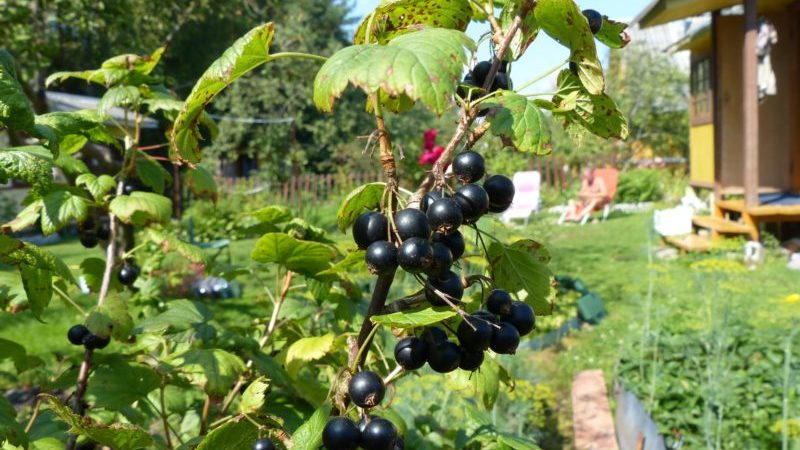
Despite the fact that the variety Ordinary Miracle is resistant to many diseases, it is better not to neglect the rules of prevention:
- Watering with boiling water... This process is called bush scalding. The procedure is carried out as soon as the snow melts, before the buds have time to swell. The water is brought to a boil and the whole bush is poured from a watering can.
- Timely feeding - another stage of prevention, because currants are often sick due to a lack of nutrients.
- In the spring, currants must be sprayed with copper sulfate. This will help prevent the development of diseases.
- Sanitary pruning - another important stage in disease prevention.
Reviews
Gardeners' reviews of the Ordinary Miracle variety are mostly positive. Everyone loves large, sweet berries.
Vasilisa, Moscow: “Currants have been growing at the dacha. An ordinary miracle for more than 8 years. I like the variety. It survives even the coldest winters perfectly, although I only mulch it, but do not huddle it. During flowering, it is important to additionally water, otherwise the berries will crack. The yield is not bad. A bucket of currants is collected from one bush. The berries are very sweet with a slight sourness. "
Irina, Tver: “An ordinary miracle has been growing on my site for 3 years already. So far there have been no problems with the plant. Although they write that it is resistant to fungal infections, I still scald the bush every spring and spray it with copper sulfate. I like the berries, but the skin is tight. "
Vladimir, Ryazan: “An ordinary miracle has been growing on the site for 6 years, but a good harvest has begun to give the last 2 years, after I planted a couple more currant bushes of other varieties. You should not rely on self-pollination of the variety. There are no other complaints, the berries are sweet and large, slightly smaller than a 2-ruble coin. "
Conclusion
Currant variety An ordinary miracle grows in all regions of Russia. It is characterized by high frost resistance - it can withstand frosts down to -40 ° C. The plant is resistant to droughts and diseases, therefore, when growing it, there are a minimum of problems. The only thing that ordinary miracle fears is stagnation of moisture.